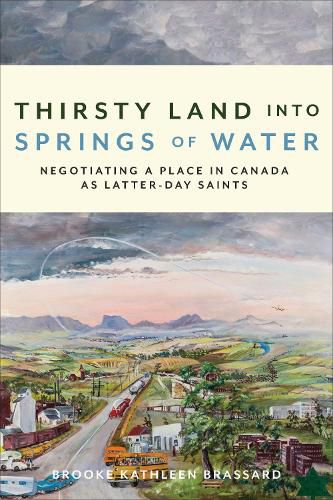Readings Newsletter
Become a Readings Member to make your shopping experience even easier.
Sign in or sign up for free!
You’re not far away from qualifying for FREE standard shipping within Australia
You’ve qualified for FREE standard shipping within Australia
The cart is loading…






Looking at the example of The Church of Jesus Christ of Latter-day Saints, Thirsty Land into Springs of Water answers questions about Canadian and religious identities, immigration, and integration. Brooke Kathleen Brassard sheds light on the Latter-day Saint experience in southern Alberta between 1887 and 1947, revealing how the Latter-day Saints integrated into Canadian society while maintaining their "peculiar" identity through architecture, business practices, political participation, gendered roles, and family structures.
Drawing on family histories, correspondence, meeting minutes, and oral histories, Brassard explores how the Church negotiated the tension between integration and otherness. The book demonstrates how Latter-day Saints in southern Alberta embedded themselves in the social, economic, and political structures of Canada and how they adapted Mormonism to Canadian circumstances. It draws on the concept of "lived religion" and historical methodologies to reveal the complications that occur in the process of negotiation for members of a minority religion in Canada. Thirsty Land into Springs of Water ultimately illuminates the ways in which mainstream Canadian society forces newcomers to decide what they will adopt, reject, or adapt in order to belong.
$9.00 standard shipping within Australia
FREE standard shipping within Australia for orders over $100.00
Express & International shipping calculated at checkout
Looking at the example of The Church of Jesus Christ of Latter-day Saints, Thirsty Land into Springs of Water answers questions about Canadian and religious identities, immigration, and integration. Brooke Kathleen Brassard sheds light on the Latter-day Saint experience in southern Alberta between 1887 and 1947, revealing how the Latter-day Saints integrated into Canadian society while maintaining their "peculiar" identity through architecture, business practices, political participation, gendered roles, and family structures.
Drawing on family histories, correspondence, meeting minutes, and oral histories, Brassard explores how the Church negotiated the tension between integration and otherness. The book demonstrates how Latter-day Saints in southern Alberta embedded themselves in the social, economic, and political structures of Canada and how they adapted Mormonism to Canadian circumstances. It draws on the concept of "lived religion" and historical methodologies to reveal the complications that occur in the process of negotiation for members of a minority religion in Canada. Thirsty Land into Springs of Water ultimately illuminates the ways in which mainstream Canadian society forces newcomers to decide what they will adopt, reject, or adapt in order to belong.